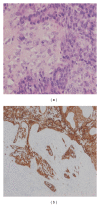Malignant adenomyoepithelioma of the breast with lymph node metastasis: a detailed immunohistochemical study
- PMID: 22934213
- PMCID: PMC3420733
- DOI: 10.1155/2012/305858
Malignant adenomyoepithelioma of the breast with lymph node metastasis: a detailed immunohistochemical study
Abstract
Malignant adenomyoepithelioma of the breast is a rare tumour with around 30 cases reported in the literature. Metastases associated with these tumours are usually haematogenous. Axillary lymph node metastases are thought to be unusual, and it has been recently suggested that axillary node dissection is not indicated unless clinically palpable. We here present a case of a 63-year-old woman, who developed a malignant adenomyoepithelioma with axillary lymph node metastasis, that included epithelial and myoepithelial elements, in spite of the absence of clinically enlarged nodes. We suggest that histological examination of axillary sentinel node(s) or node sampling may be worthwhile in this condition.
Figures



References
-
- Hayes MM. Adenomyoepithelioma of the breast: a review stressing its propensity for malignant transformation. Journal of Clinical Pathology. 2011;64(6):477–484. - PubMed
-
- Hamperl H. The myothelia (myoepithelial cells). Normal state; regressive changes; hyperplasia; tumors. Current Topics in Pathology. 1970;53:161–220. - PubMed
-
- Ahmed AA, Heller DS. Malignant adenomyoepithelioma of the breast with malignant proliferation of epithelial and myoepithelial elements: a case report and review of the literature. Archives of Pathology and Laboratory Medicine. 2000;124(4):632–636. - PubMed
-
- Choi SY, Kim JS, Kim SJ, Kim YJ, Kim L, Young UC. Malignant adenomyoepithelioma of the breast presenting as a large mass that grew slowly without metastasis. Journal of Breast Cancer. 2009;12(3):219–222.
-
- Khurana A, Jalpota Y. Myoepithelial carcinoma arising in an adenomyoepithelioma of the breast: a case report of a rare entity. Indian Journal of Pathology and Microbiology. 2010;53(2):310–312. - PubMed
Publication types
LinkOut - more resources
Full Text Sources

